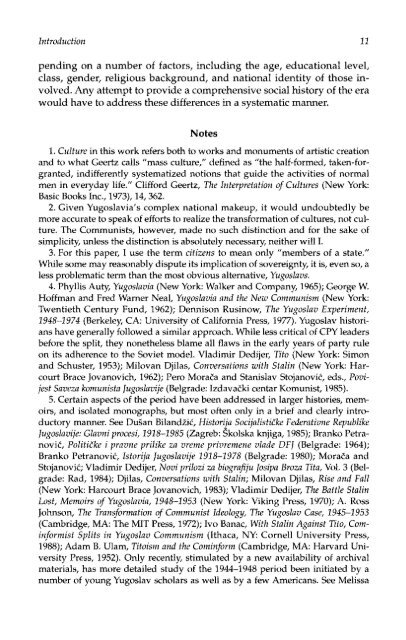Part Two - Indymedia
Part Two - Indymedia
Part Two - Indymedia
Create successful ePaper yourself
Turn your PDF publications into a flip-book with our unique Google optimized e-Paper software.
Introduction 11<br />
pending on a number of factors, including the age, educational level,<br />
class, gender, religious background, and national identity of those involved.<br />
Any attempt to provide a comprehensive social history of the era<br />
would have to address these differences in a systematic manner.<br />
Notes<br />
1. Culture in this work refers both to works and monuments of artistic creation<br />
and to what Geertz calls "mass culture," defined as "the half-formed, taken-forgranted,<br />
indifferently systematized notions that guide the activities of normal<br />
men in everyday life." Clifford Geertz, The Interpretation of Cultures (New York:<br />
Basic Books Inc., 1973), 14,362.<br />
2. Given Yugoslavia's complex national makeup, it would undoubtedly be<br />
more accurate to speak of efforts to realize the transformation of cultures, not culture.<br />
The Communists, however, made no such distinction and for the sake of<br />
simplicity, unless the distinction is absolutely necessary, neither will I.<br />
3. For this paper, I use the term citizens to mean only "members of a state."<br />
While some may reasonably dispute its implication of sovereignty, it is, even so, a<br />
less problematic term than the most obvious alternative, Yugoslavs,<br />
4. Phyllis Auty, Yugoslavia (New York: Walker and Company, 1965); George W.<br />
Hoffman and Fred Warner Neal, Yugoslavia and the New Communism (New York:<br />
Twentieth Century Fund, 1962); Dennison Rusinow, The Yugoslav Experiment,<br />
1948-1974 (Berkeley, CA: University of California Press, 1977). Yugoslav historians<br />
have generally followed a similar approach. While less critical of CPY leaders<br />
before the split, they nonetheless blame all flaws in the early years of party rule<br />
on its adherence to the Soviet model. Vladimir Dedijer, Tito (New York: Simon<br />
and Schuster, 1953); Milovan Djilas, Conversations with Stalin (New York: Harcourt<br />
Brace Jovanovich, 1962); Pero Mora£a and Stanislav Stojanovic, eds., Povijest<br />
Saveza kamunista fugoslavije e (Belgrade: Izdavacki centar Komunist, 1985).<br />
5. Certain aspects of the period have been addressed in larger histories, memoirs,<br />
and isolated monographs, but most often only in a brief and clearly introductory<br />
manner. See Dusan Bilandzic, Historija nSodjalistiCke e Federativne Eepublike<br />
Jugoslavije: Glavni procesi, 1918-1985 (Zagreb: Skolska knjiga, 1985); Branko Petranovic,<br />
Politiflte e i pmvne prilike za vrerne priwemene vlade DFJ (Belgrade: 1964);<br />
Branko Petranovifi, Istorija Jugoslavije 1918-1978 (Belgrade: 1980); Morafia and<br />
Stojanovic; Vladimir Dedijer, Novi prilozi za biografiju Josipa Broza Tita, Vol. 3 (Belgrade:<br />
Rad, 1984); Djilas, Conversations with Stalin; Milovan Djilas, Rise and Fall<br />
(New York: Harcourt Brace Jovanovich, 1983); Vladimir Dedijer, The Battle Stalin<br />
Lost, Memoirs of Yugoslavia, 1948-1953 (New York: Viking Press, 1970); A. Ross<br />
Johnson, The Transformation of Communist Ideology, The Yugoslav Case, 1945-1953<br />
(Cambridge, MA: The MIT Press, 1972); Ivo Banac, With Stalin Against Tito, Caminformist<br />
Splits in Yugoslav Communism (Ithaca, NY: Cornell University Press,<br />
1988); Adam B. Ulam, Titoism and the Cominform m(Cambridge, MA: Harvard University<br />
Press, 1952). Only recently, stimulated by a new availability of archival<br />
materials, has more detailed study of the 1944-1948 period been initiated by a<br />
number of young Yugoslav scholars as well as by a few Americans. See Melissa
















